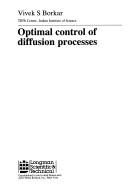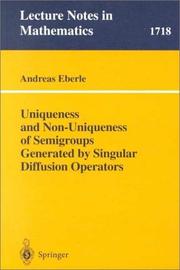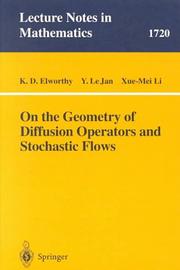| Listing 1 - 3 of 3 |
Sort by
|

ISSN: 02693674 ISBN: 0470213272 9780470213278 Year: 1989 Volume: 203 Publisher: Harlow, Essex, England: Longman scientific and technical,
Abstract | Keywords | Export | Availability | Bookmark
 Loading...
Loading...Choose an application
- Reference Manager
- EndNote
- RefWorks (Direct export to RefWorks)
Bedieningstheorie --- Commande [Theorie de la ] --- Control theory --- Diffusieproces --- Diffusion processes --- Mathematical optimization --- Optimalisation mathématique --- Processus de diffusion --- Wiskundige optimisatie

ISBN: 3540666281 3540480765 Year: 1999 Volume: 1718 Publisher: New York Springer
Abstract | Keywords | Export | Availability | Bookmark
 Loading...
Loading...Choose an application
- Reference Manager
- EndNote
- RefWorks (Direct export to RefWorks)
This book addresses both probabilists working on diffusion processes and analysts interested in linear parabolic partial differential equations with singular coefficients. The central question discussed is whether a given diffusion operator, i.e., a second order linear differential operator without zeroth order term, which is a priori defined on test functions over some (finite or infinite dimensional) state space only, uniquely determines a strongly continuous semigroup on a corresponding weighted Lp space. Particular emphasis is placed on phenomena causing non-uniqueness, as well as on the relation between different notions of uniqueness appearing in analytic and probabilistic contexts.
Stochastic processes --- Diffusion processes --- Differential equations, Parabolic --- Mathematical Theory --- Mathematical Statistics --- Mathematics --- Physical Sciences & Mathematics --- Differentiaalvergelijkingen [Parabolische ] --- Differential equations [Parabolic] --- Diffusieproces --- Equations differentielles paraboliques --- Processus de diffusion --- Probabilities. --- Partial differential equations. --- Group theory. --- Potential theory (Mathematics). --- Probability Theory and Stochastic Processes. --- Partial Differential Equations. --- Group Theory and Generalizations. --- Potential Theory. --- Green's operators --- Green's theorem --- Potential functions (Mathematics) --- Potential, Theory of --- Mathematical analysis --- Mechanics --- Groups, Theory of --- Substitutions (Mathematics) --- Algebra --- Partial differential equations --- Probability --- Statistical inference --- Combinations --- Chance --- Least squares --- Mathematical statistics --- Risk --- Diffusion processes. --- Differential equations, Parabolic. --- Parabolic differential equations --- Parabolic partial differential equations --- Differential equations, Partial --- Markov processes

ISBN: 3540667083 3540470220 Year: 1999 Volume: 1720 Publisher: New York Springer
Abstract | Keywords | Export | Availability | Bookmark
 Loading...
Loading...Choose an application
- Reference Manager
- EndNote
- RefWorks (Direct export to RefWorks)
Stochastic differential equations, and Hoermander form representations of diffusion operators, can determine a linear connection associated to the underlying (sub)-Riemannian structure. This is systematically described, together with its invariants, and then exploited to discuss qualitative properties of stochastic flows, and analysis on path spaces of compact manifolds with diffusion measures. This should be useful to stochastic analysts, especially those with interests in stochastic flows, infinite dimensional analysis, or geometric analysis, and also to researchers in sub-Riemannian geometry. A basic background in differential geometry is assumed, but the construction of the connections is very direct and itself gives an intuitive and concrete introduction. Knowledge of stochastic analysis is also assumed for later chapters.
Stochastic processes --- Mathematical Theory --- Mathematics --- Physical Sciences & Mathematics --- Diffusieproces --- Diffusion processes --- Flows (Differentiable dynamical systems) --- Flows (Differentieerbare systemen) --- Flows (Systèmes dynamiques différentiables) --- Lineaire operatoren --- Linear operators --- Opérateurs linéaires --- Processus de diffusion --- Probabilities. --- Functional analysis. --- Differential geometry. --- Global analysis (Mathematics). --- Manifolds (Mathematics). --- Probability Theory and Stochastic Processes. --- Functional Analysis. --- Differential Geometry. --- Global Analysis and Analysis on Manifolds. --- Geometry, Differential --- Topology --- Analysis, Global (Mathematics) --- Differential topology --- Functions of complex variables --- Geometry, Algebraic --- Differential geometry --- Functional calculus --- Calculus of variations --- Functional equations --- Integral equations --- Probability --- Statistical inference --- Combinations --- Chance --- Least squares --- Mathematical statistics --- Risk
| Listing 1 - 3 of 3 |
Sort by
|

 Search
Search Feedback
Feedback About UniCat
About UniCat  Help
Help News
News